Some say U. S. race relations are improving; others say not. Some say that affirmative action has fostered racial progress; others say not. But almost all Americans, liberal or conservative, agree that in the long run racial equality can be fully achieved only by eliminating disparities in the average educational performances of blacks and whites. Most Americans, we submit, would go so far as to say that if the next generation of blacks and whites acquire similar academic skills, the remaining barriers to racial equality could well slip away of their own accord.
But despite the broad consensus for education’s central importance, the United States tolerates the isolation of half of its African-American children in public school within an unsafe and severely underperforming system. Any serious attempt to eliminate racial inequities must correct this glaring blot on the nation’s racial report card.
Central-City Schools
Half of all African Americans, but only 20 percent of whites, in public school attend central-city schools. In the largest U.S. cities, the racial differences between central-city and suburban schools are even more dramatic. In Chicago, Dallas, Detroit, Houston, Los Angeles, and Washington, more than 85 percent of public school students are of minority background.
Unfortunately, it is in these big cities that public schools fail their students most miserably and the costs of failure are most severe. According to a national survey carried out in 1996, only 46 percent of urban students read at a “basic” level, as compared with 63 percent of students in nonurban areas. Among high-poverty schools, the differences are even greater. Only 23 percent of students at urban high-poverty schools read at the basic level as compared with 46 percent in nonurban high-poverty areas. Similar performances for urban schools were reported in math and science. As columnist William Raspberry recently put it in the Washington Post, “Poor children desperately need better education.Yet the schools they attend—particularly in America’s overwhelmingly black and brown inner cities—may be the least successful of all public schools.”
In most big cities, average test scores fall as students advance through the public schools. For example, early last year a New York Times article matched New York City students against statewide averages, controlling for student’ racial and income status. It found that they scored 3 percentile points behind the statewide average in third grade, 6 percentile points behind in sixth grade, and as much as 15 points behind in high school.
According to Department of Education statistics, the share of all students who go to private schools is much higher in big cities (15.8 percent) than in either suburban (11.7 percent) or rural areas (5.4 percent). Lacking the resources to follow suit, low-income central-city families often find themselves forced to accept the school to which their child is assigned, leaving many dissatisfied. A New York Times article reported last December, for example, that 93 percent of blacks in Denver agreed that “some children in the Denver public school system are receiving a substandard education.”
As evidence of urban school failure piles up, Urban League President Hugh Price has put big-city schools on notice: “If urban schools…continue to fail in the face of all we know about how to improve them, then [parents] will be obliged to shop elsewhere for quality education. We Urban Leaguers believe passionately in public education. But make no mistake. We love our children even more.”
Flocking to Vouchers
Fed up with central-city schools, many African Americans are beginning to throw their support behind school vouchers. When Stanford professor Terry Moe recently conducted a nationwide survey of 4,700 parents, he found that school choice commands the greatest support in central cities: 79 percent of the inner-city poor favor a “voucher plan,” compared with 59 percent of whites living in more advantaged communities. And 61 percent of the inner-city poor “strongly” favor vouchers, as against just 31 percent of the advantaged whites.
A national survey of black and white Americans last year by the Joint Center of Political and Economic Studies also found the greatest support for vouchers among African Americans: 57 percent, as compared with 47 percent of white respondents. Younger and poorer African Americans were the most supportive. Finally, a poll conducted last summer by Phi Delta Kappa, a professional education association, found that 72 percent of black respondents favored vouchers, compared with just 48 percent of the general population.
Choice Schools
Though few are prepared to defend central-city schools, some wonder whether giving inner-city children a chance to go to a private school will make much difference. Studies of five state or privately funded voucher or scholarship programs that offer low-income inner-city students a choice of private schools, religious or secular, provide some answers to often-asked questions. Two of the five programs are in Milwaukee; the others, in Indianapolis, Cleveland, and New York City (table 1).
Most students in these programs come from disadvantaged families. In all cities except Indianapolis most are likely to be African American. Most come from one-parent families. Many receive welfare, Medicaid, food stamps, or other government assistance. Average test scores are well below national norms. However, a majority of students come from families in which at least one parent says he or she has had some college education, though these self-reports may be inflated.
Satisfaction with Choice Schools
Participating families love their choice schools. A year into the Cleveland choice program, parent Pamela Ballard exclaimed, “HOPE Academy was my last hope. I took my third-grade child, who had been in several Cleveland schools and was labeled a “problem child.” I now have a successful child. Where there were D’s and C’s, there are now A’s and B’s.”
Ballard’s enthusiam represents the norm, not the exception. According to three different studies, choice schools are more popular than public schools (see table 2). The studies use slightly different methodologies and ask somewhat different questions, some about teachers and instruction, others about the amount learned, discipline, safety, and parental involvement. But the results do not depend much on the methodology or the question. Almost always, parents prefer choice to public schools, usually by large margins.
Nor do impartial observers disagree with parents’ positive assessments. In Milwaukee, for example, a reporter for Education Week reached much the same conclusions that Milwaukee parents did: “Classes here are highly structured and yet free of regimentation; there is a sense of order, yet order itself is not the point. The activities are purposeful; the students enthusiastic participants.” But it is one seventh grader who, in a Carnegie Foundation for the Advancement of Teaching interview, made the most convincing case for her new school: “As soon as I came here it was a big change. Here, teachers care about you… [In public school] the teachers were too busy to help.” Worst of all, she said, were the fights: “You really can’t avoid it. They’ll think you’re scared.”
Most revealing of all, school teachers are more likely than the average central-city resident to pick a private school for their own son or daughter. As Dennis Doyle noted in a 1995 report for the Center for Education Reform, 40 percent of the children of Cleveland public school teachers go to private school, as compared with 25 percent of all children. In Milwaukee the percentages are 33 as compared with 23, in Boston 45 as compared with 29.
Test Scores
Students also seem to learn more in choice schools. In Cleveland, for example, students in two schools (that enrolled about 25 percent of the former public school students) made significant gains in both math and reading. The Cleveland findings, however, may be contaminated by what is known as the selection effect. After all, families who are clever and motivated enough to get a scholarship are likely to have other attributes that spur their children’s educational attainment. But higher-quality data are available from the choice experiment in Milwaukee, where the students applying for choice were assigned to a test or control group by means of a lottery.
Our examination of the Milwaukee data showed that a student’s enrollment in the program had only modest effects during the first two years. But by years three and four, choice students began outstripping their peers in the control group. If such gains can be duplicated nationwide, they could reduce by between one-third and one-half the current difference between white and minority test score performance.
It should not be surprising that student performance does not improve considerably until the third and fourth years. Choice schools are not magic bullets. Education does not happen overnight; it takes time to adjust to a new teaching and learning environment. The disruption of switching schools and adjusting to new routines and expectations may hamper improvement in test scores in the first year or two in a choice school. Educational benefits accumulate and multiply with the passage of time.
Democratic Values and Balkanization
Choice critics point out that the purpose of education is not merely to teach math and reading, but also to prepare citizens for a democratic society. According to critics such as former New Republic editor Michael Kelly, “Public money is shared money, and it is to be used for the furtherance of shared values, in the interests of e pluribus unum. Charter schools and their like…take from the pluribus to destroy the unum.”
It was, after all, not so long ago that choice privatization was a strategy favored by those seeking to avoid compliance with the Supreme Court’s 1954 Brown v. Board of Education decision. But other courts went on to strike down these misguided attempts to perpetuate racial segregation, precluding such strategies in the future. The evidence from most private schools today is that privatization leads to less balkanization, not more.
Today’s private school students are less racially isolated than their public school peers. According to 1992 Department of Education data, 37 percent of private school students are in classrooms whose share of minority students is close to the national average, compared with only 18 percent of public school students. Not only are private school students more likely to be in well-integrated classrooms, they are less likely to be in extremely segregated ones (either more than 90 percent white or more than 90 percent minority). Forty-one percent of private school students are in highly segregated classrooms, as compared with 55 percent of their public school peers.
Private school students also report more positive relationships with students from other racial and ethnic groups. According to the same 1992 survey, they are significantly more likely to have cross-racial friendships than are students at public schools. And students, teachers, and administrators at private schools all report fewer racial problems.
Private school students are also more community-spirited. According to the 1992 survey, students at private schools are more likely than public school students to think that it is important to help others and volunteer for community causes. They also are more likely to report that they in fact did volunteer in the past two years and to say their school expected them to do so.
The Church-State Question
Federal constitutional questions may not pose as much of a stumbling block to school choice as it once seemed, despite some lower court decisions to the contrary. State-provided scholarships do not “establish a religion” as long as parents are free to use them to send their children to any school, Catholic, Protestant, Jewish, Muslim, or secular. The Supreme Court so reasoned in 1983 (Mueller v. Allen) when it ruled constitutional a Minnesota tax deduction for educational expenses, whether for secular or for parochial schooling. And it reaffirmed that reasoning in Agostini v. Felton (1997), when it said that public school teachers could provide compensatory educational instruction in parochial schools. The Court conditioned its decision on policies that made instruction “available generally without regard to the sectarian-nonsectarian or public-nonpublic nature of the institution benefitted,” further justifying its decision on the grounds that no religion was aided except as the result of the “private choices of individuals.” Most school choice programs easily pass such a test.
Competition Can Invigorate Public Schools
But how about those left behind? American Federation of Teachers President Sandra Feldman has said that vouchers and scholarships for private schools take “money away from inner-city schools so a few selected children can get vouchers to attend private schools, while the majority of equally deserving kids, who remain in the public schools, are ignored.”
Yet there is little reason to expect the best and the brightest to flee the public schools to take advantage of inner-city choice programs. For one thing, most big-city school systems have their own special programs—magnet schools, gifted classes, and honors tracks—that siphon off the best students. Also, parents can be expected not to change their children’s school unless they have doubts about their progress. In New York City, only 26 percent of those applying for choice schools scored at grade level on the reading test, far below the 55 percent of all elementary school students scoring at that level as reported by the city’s school system.
The creaming of inner-city public schools took place long before school choice arrived on the public agenda. In America’s biggest cities, the middle-class population has already left for suburbia or for private schools. Indeed, one attraction of inner-city school choice is the possibility that it could reduce racial isolation within the central city.
Speaking to a Pittsburgh conference on urban renewal last July, Milwaukee’s visionary mayor, John Norquist, argued that if school choice becomes a reality, “public schools will respond to private-sector competition with an aggressive effort to maintain their clientele, just as United and American Airlines did.” Empowered to choose among a variety of schools, young parents with children entering school will forgo the expensive move to the suburbs and pick instead a local school suited to their needs. Other families, offered better schools in the cities, will give up their suburban homes to live closer to their jobs. Businesses will open schools so their employees can bring their children with them on their daily commute. The central-city economy will pick up, property values will rise, racial integration will increase, and central-city test scores will rise.
Government Responsibility?
School choice is not a panacea that can resolve all of society’s race-related problems. It will not by itself eliminate all the differences in the educational performances of racial groups. Much of what we know, we learn not in school but from our families, friends, and myriad other life experiences. But schools are one of the most important sources available to the government for the amelioration of racial inequity.
Unfortunately, many have come to believe that for government to achieve that objective, it must directly operate the educational system it finances. But government often can better achieve its goals by mobilizing the energies of churches, nonprofits, and profit-making institutions. In most policy arenas—transportation, health services, scientific research, pollution contro—that is the strategy government typically follows. When government-operated institutions, such as central-city schools, have fallen into a serious state of disrepair, it is even more crucial that government find alternative ways of achieving common objectives. As William Raspberry urgently recommends: “It’s time for some serious experimentation.”
The Brookings Institution is committed to quality, independence, and impact.
We are supported by a diverse array of funders. In line with our values and policies, each Brookings publication represents the sole views of its author(s).
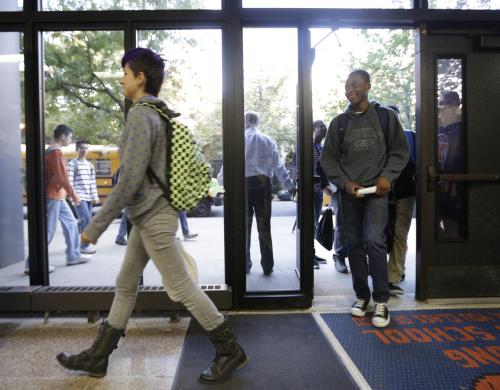
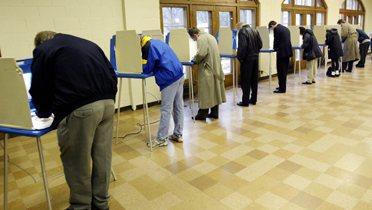
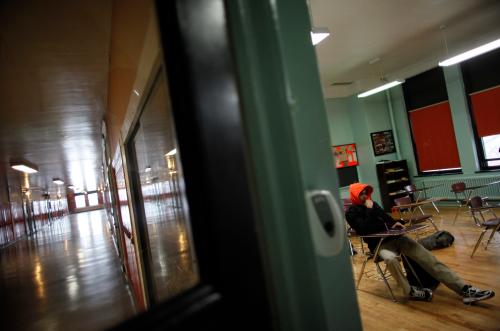
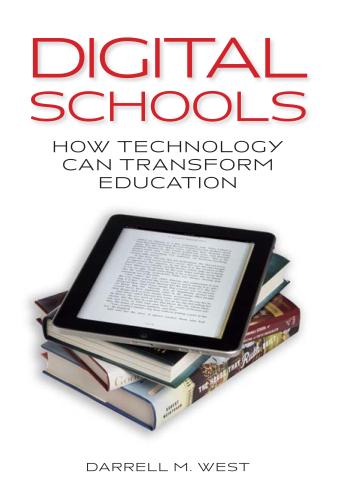

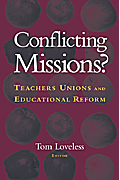



Commentary
Race Relations & Central City Schools: It’s time for an experiment with vouchers
March 1, 1998